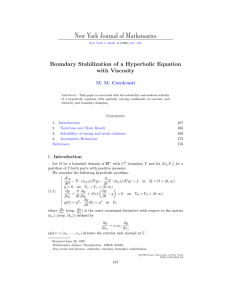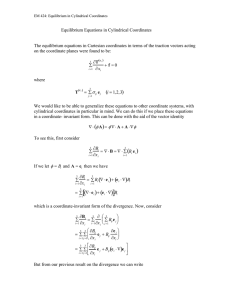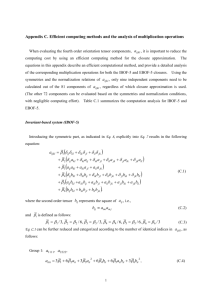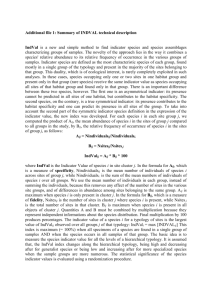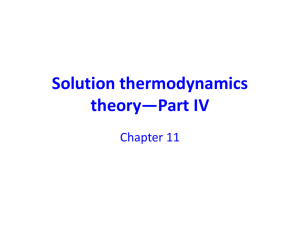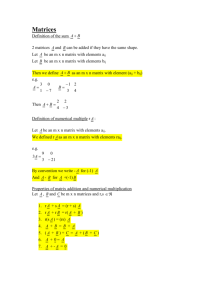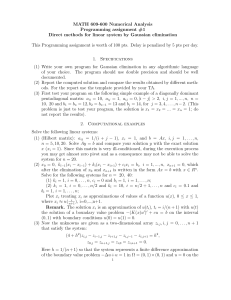Document 10749664
advertisement
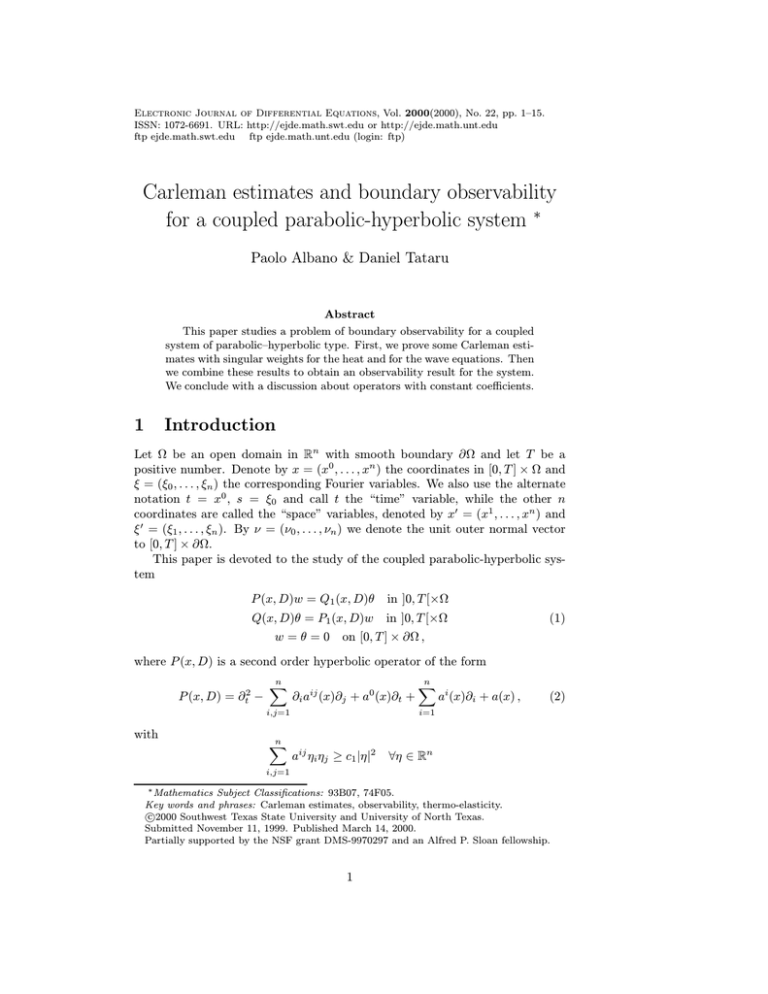
Electronic Journal of Differential Equations, Vol. 2000(2000), No. 22, pp. 1–15.
ISSN: 1072-6691. URL: http://ejde.math.swt.edu or http://ejde.math.unt.edu
ftp ejde.math.swt.edu ftp ejde.math.unt.edu (login: ftp)
Carleman estimates and boundary observability
for a coupled parabolic-hyperbolic system ∗
Paolo Albano & Daniel Tataru
Abstract
This paper studies a problem of boundary observability for a coupled
system of parabolic–hyperbolic type. First, we prove some Carleman estimates with singular weights for the heat and for the wave equations. Then
we combine these results to obtain an observability result for the system.
We conclude with a discussion about operators with constant coefficients.
1
Introduction
Let Ω be an open domain in Rn with smooth boundary ∂Ω and let T be a
positive number. Denote by x = (x0 , . . . , xn ) the coordinates in [0, T ] × Ω and
ξ = (ξ0 , . . . , ξn ) the corresponding Fourier variables. We also use the alternate
notation t = x0 , s = ξ0 and call t the “time” variable, while the other n
coordinates are called the “space” variables, denoted by x0 = (x1 , . . . , xn ) and
ξ 0 = (ξ1 , . . . , ξn ). By ν = (ν0 , . . . , νn ) we denote the unit outer normal vector
to [0, T ] × ∂Ω.
This paper is devoted to the study of the coupled parabolic-hyperbolic system
P (x, D)w = Q1 (x, D)θ
in ]0, T [×Ω
Q(x, D)θ = P1 (x, D)w in ]0, T [×Ω
w = θ = 0 on [0, T ] × ∂Ω ,
(1)
where P (x, D) is a second order hyperbolic operator of the form
P (x, D) = ∂t2 −
n
X
∂i aij (x)∂j + a0 (x)∂t +
i,j=1
with
n
X
n
X
ai (x)∂i + a(x) ,
(2)
i=1
aij ηi ηj ≥ c1 |η|2
∀η ∈ Rn
i,j=1
∗ Mathematics Subject Classifications: 93B07, 74F05.
Key words and phrases: Carleman estimates, observability, thermo-elasticity.
c
2000
Southwest Texas State University and University of North Texas.
Submitted November 11, 1999. Published March 14, 2000.
Partially supported by the NSF grant DMS-9970297 and an Alfred P. Sloan fellowship.
1
2
Carleman estimates and boundary observability
EJDE–2000/22
and Q(x, D) is a second order parabolic operator of the form
Q(x, D) = ∂t −
n
X
∂i bij (x)∂j +
i,j=1
with
n
X
bij ηi ηj ≥ c2 |η|2
n
X
bi (x)∂i + b(x) ,
(3)
i=1
∀η ∈ Rn
i,j=1
for some positive constants c1 and c2 .
The coupling terms Q1 (x, D) and P1 (x, D) are a second order operator (with
respect to the “space” variables) and a first order operator (with respect all the
variables) respectively1 . We point out that equations of the form (1) arise in
the study of linear thermo-elasticity (see e.g. [9] and references therein).
We are concerned with the following question. Knowing that the normal
derivatives ∂ν w and ∂ν θ are equal to 0 on [0, T ] × ∂Ω can we conclude that
w = θ = 0, in [0, T ] × Ω? More precisely, for any solution (w, θ) of problem (1),
we want to prove an observability estimate of the form
k(w, θ)k ≤ Ck∂ν (w, θ)k∂
where k · k and k · k∂ are suitable interior and boundary Sobolev norms. In other
words, this would say that the solution (w, θ) can be reconstructed in a stable
fashion if one observes its conormal derivative on the boundary. Note that the
initial data cannot be recovered stably due to the parabolic regularizing effect.
However, the final data at time T can be obtained. By duality this implies an
exact null controllability result for the adjoint problem.
The affirmative answer to the previous question (for sufficiently large T ) is
given using a–priori estimates of Carleman type. These estimates have been
introduced in [2], and were intensively studied in [4] (for hyperbolic and elliptic
operators) and in [6] (in the case of anisotropic operators). A general approach
to Carleman estimates for boundary value problems was developed in [10, 12].
Carleman estimates for the initial boundary value problem for the heat equations have been independently obtained in [3, 5] and [13] while the analogous
results in the case of hyperbolic equations were proved in [11]. We remark that
other approaches to the observability problem for hyperbolic equations have
been developed in [7] (using multipliers method) and in [1] (using microlocal
analysis). For what concerns observability estimates for the heat equations, an
observability result was proved in [8] using microlocal analysis and Carleman
estimates for elliptic equations.
We start by deriving a Carleman estimate with singular weight for the heat
equation. Next, we deduce a similar estimate for the wave equation. Finally,
putting together the previous estimates we get an observability estimate for
the coupled system, which, in particular, yields an affirmative answer to our
1 Alternately one can take Q to be first order and P second order and obtain similar
1
1
results
EJDE–2000/22
Paolo Albano & Daniel Tataru
3
question. We point out that the last step will require a precise control on
the constant that appear on the Carleman estimate for the heat equation. We
conclude the paper discussing the case when P and Q have constant coefficients.
2
Notation and assumptions
We will use short notation
∂j =
∂
,
∂xj
ui1 ...ik = ∂i1 . . . ∂ik u .
The symbols u0 and ut indicate the derivative of u with respect to t, ∇ represents
the gradient with respect to all the variables while ∇0 = (∂1 , . . . ∂n ) is the spatial
gradient.
By H s we denote the classical Sobolev spaces, with norm k · ks while k · k
stands for the L2 norm. In the Carleman estimates we use weighted Sobolev
norms. Given a nonnegative function η define
X Z
2
η 2(k−|α|) |∂ α u|2 dx
kukk,η =
|α|≤k
and the corresponding parabolic (anisotropic) norm
X Z
η 2(k−|α|a ) |∂ α u|2 dx
kuk2k,a,η =
|α|a ≤k
where ∂ α = ∂0α0 . . . ∂nαn and |α|a = 2α0 + α1 + . . . + αn . All these norms can
also be defined in a bounded domain in a standard manner.
Denote by p(x, ξ) and q(x, ξ) the principal symbols of P and Q respectively.
They are given by
n
X
p(x, ξ) = −ξ02 +
aij (x)ξi ξj
i,j=1
respectively
q(x, ξ) = iξ0 +
n
X
bij (x)ξi ξj
i,j=1
As usual, a covector N is called time–like if p(N ) < 0 and space–like if
p(N ) > 0. We can split the time-like class into forward time-like and backward
time-like with respect to a reference time-like vector field. This role is played
naturally in our case by ∂0 . Consequently, we say that a time-like covector
N is forward if N0 > 0 and is backward if N0 < 0. A hypersurface S is called
space–like if p(N ) < 0 and time–like if p(N ) > 0, where N ∈ N ∗ S, the conormal
bundle. If p(N ) = 0 then the hypersurface is called characteristic.
Next we introduce the notion of pseudoconvexity. For general operators this
is a bit more complicated, but here we give only the simpler form which is
adapted to second order hyperbolic equations.
4
Carleman estimates and boundary observability
EJDE–2000/22
Definition 2.1 We say that the level sets of a C 2 function φ are strongly pseudoconvex with respect to the operator P at x iff
{p, {p, φ}}(x, ξ) > 0
{ξ 6= 0 : p(x, ξ) = {p, φ}(x, ξ) = 0}
on
(4)
and
{{p, φ}, p(x, ∇φ)} > 0
on
{p(x, ∇φ) = 0}
(5)
Here by {·, ·} we have denoted the usual Poisson bracket
{p, q} =
n
X
pξj qxj − qξj pxj .
j=0
In order to derive our observability result we use the following assumptions
(H1) the coefficients of the principal part of P and Q are of class C 1 while the
lower order and the coupling terms are measurable and bounded.
(H2) There exists a smooth2 function φ in ]0, T [×Ω whose level sets are pseudoconvex with respect to P (x, D) so that
(i) ∇0 φ(x) 6= 0 , for all x ∈]0, T [×Ω.
(ii) ∇φ is forward time–like at time 0.
(iii) ∇φ is backward time–like at time T .
We remark that assumption (H2)(i) ensures that the level sets of φ are pseudoconvex surfaces with respect to Q.
It is well–known that the finite speed of propagation of P implies that the
“observability time” T must be large enough. Indeed, take P1 = Q1 = 0, and
consider the initial value problem for the wave equation with the Cauchy data
localized in a small set away from ∂Ω. Then, it is easy to see that, for small T,
we get a solution of P u = 0 with u not identically zero and kuk∂ = 0. In other
words, one cannot expect that observability holds true for every T > 0.
More precisely, it was proved in [1] that one can have boundary observability
iff any bicharacteristic ray hits the boundary at least once in a nondiffractive
point. The bicharacteristic flow is not well defined if the coefficients are only
C 1 . However, if the coefficients are C 2 then the condition (H2) guarantees that
such a geometrical assumption is fulfilled. Indeed, let us suppose that γ be
a null bicharacteristic ray goes from 0 to T without leaving [0, T ] × Ω. Now,
from assumptions (H2)(ii) and (iii) it is easy to deduce that φ possesses a
maximum point at some t ∈ (0, T ). On the other hand, the pseudoconvexity of
φ implies that {p, {p, φ}} > 0. However, since {p, {p, φ}}(γ) is in fact the second
derivative of φ along γ it cannot be strictly positive at a maximum point.
2 In
effect piecewise smooth and semiconvex is sufficient.
EJDE–2000/22
3
Paolo Albano & Daniel Tataru
5
The heat equation
Consider the parabolic initial boundary value problem
Q(x, D)θ(x) = f (x) in ]0, T [×Ω ,
θ = 0 on [0, T ] × ∂Ω ,
0
(6)
0
θ(0, x ) = θ0 (x ) in Ω ,
with (f, θ0 ) ∈ L2 ([0, T ] × Ω) × H01 (Ω). Our goal is to prove a Carleman estimate
of the form
keτ ψ θk ≤ keτ ψ f k + keτ ψ ∂ν θk∂ ,
with appropriate norms and a suitable function ψ, uniformly with respect to
the large parameter τ . The obstruction to such an estimate is that no Sobolev
norm of the initial data can be controlled by the right hand side. Hence the
only hope is to consider a weight function ψ which approaches −∞ at time 0.
Estimates of this type have already been proved in ([3, 5] and [13]). The novelty
here is that we give a direct proof and that we achieve a better control of the
constants arising in the estimate.
Thus, we introduce a C 2 function g defined as
1
for t near 0 ,
t
for t ∈ [0, δ] ,
strictly decreasing
1
for t ∈ [δ, T − δ] ,
(7)
g(t) =
strictly
increasing
for
t
∈
[T
−
δ,
T
]
,
1
for t near T ,
T −t
for some δ > 0. Let φ(x) be a function such that
∇0 φ(x) 6= 0
for all x ∈ [0, T ] × Ω .
(8)
Define
ψ(x) := g(x0 ) eλφ(x) − 2eλΦ ),
Φ = kφkL∞ ((0,T )×Ω) ,
(9)
The weight function ψ thus defined approaches −∞ at times 0, T . The additional parameter λ is essential in order to obtain the control of the constants
which enables us to handle arbitrarily large coefficients in the coupling terms.
Theorem 3.1 Assume that (H1) is fulfilled. Let ψ be given as in (9) with φ
satisfying (8). Let θ be the solution of problem (6). Then there exists λ0 so that
for each λ > λ0 there exists τ (λ) so that for τ > τ (λ) the following estimate
holds uniformly in λ, τ :
Z
−1
Cλkτp 2 eτ ψ θk22,τp ,a ≤ keτ ψ f k2 +
τp e2τ ψ (νi bij φj )(νi bij νj )|∂ν θ|2 dσ ,
[0,T ]×∂Ω
Here τp = λτ geλφ .
(10)
6
Carleman estimates and boundary observability
EJDE–2000/22
Proof: Since the estimate (10) is independent of the lower order terms of Q we
can assume that
Q(x, D) = ∂0 − ∂i bij ∂j ,
where, for simplicity, we dropped the summation sign. As usual, with the
substitution v = eτ ψ θ, the estimate (10) reduces to
Z
−1
Cλkτp 2 vk22,τp ,a ≤ kQτ vk2 +
τp (νi bij φj )(νi bij νj )|∂ν v|2 dσ ,
(11)
[0,T ]×∂Ω
where Qτ is the conjugated operator defined as
Qτ (x, D) := eτ ψ Q(x, D)e−τ ψ .
Note that the definition of v implies that
v(0, x0 ) = v(T, x0 ) = 0 in Ω
v = 0 on [0, T ] × ∂Ω .
Split Qτ into
where
(12)
Qτ (x, D) = Qaτ (x, D) + Qsτ (x, D)
Qaτ (x, D) = ∂t + τ (∂i bij (x) ψj + ψi bij (x)∂j )
is the skew-symmetric part of Qτ while
Qsτ (x, D) = −∂i bij (x)∂j − τ 2 ψi bij (x)ψj − τ ψt
is the symmetric part of Qτ . Since
kQτ vk2 = kQsτ vk2 + kQaτ vk2 + 2hQaτ v, Qsτ vi ,
(13)
the crucial step of the proof will be to estimate from below hQaτ v, Qsτ vi integrating by parts. It is easy to see that h∂t v , Qsτ vi is a lower order term compared
to the left hand side in (11) since
2h∂t v , Qsτ vi
therefore
=
=
h[Qsτ , ∂t ]v, vi
−h(∂t bij )∂i v, ∂j vi + h(∂t (τ 2 ψi bij (x)ψj + τ ψt )v, vi
3
|h∂t v , Qsτ vi| ≤ ck∇0 vk2 + cλ τ 2 kg 2 vk2 ,
for some positive constants c, cλ . Similarly, for some cλ > 0,
3
|h τ (∂i bij (x)ψj + ψi bij (x)∂j )v, τ ψt vi| ≤ cλ τ 2 kg 2 vk2 .
Then it remains to estimate
−τ h(∂i bij ψj + ψi bij ∂j )v, (∂k bkl ∂l + τ 2 ψk bkl ψl )vi .
EJDE–2000/22
Paolo Albano & Daniel Tataru
7
Compute first the leading zero order terms. Integrating by parts, we get
−τ h(∂i bij ψj + ψi bij ∂j )v , τ 2 ψk bkl ψl vi = τ 3 hbij ψj v, (∂i ψk bkl ψl )vi .
Since ψk = λg(x0 )φk eλφ(x) , the highest order terms occur when the derivative
falls on the exponential. Hence we get
2
−τ h(∂i bij ψj + ψi bij ∂j )v , τ 2 ψk bkl ψl vi = 2λhτp3 φi bij φj v , vi + R
(14)
where R stands for lower order terms,
−1
R = O(kτp 2 vk22,τp ,a ).
Now compute the leading first order terms integrating by parts the expression
−τ h(∂i bij ψj + ψi bij ∂j )v , ∂k bkl ∂l vi .
Since one operator is selfadjoint and the other is skew-adjoint, we need to
compute their commutator. This might seem complicated at first; however,
it simplifies considerably once we observe that every time a derivative falls
on the coefficients bij we produce a lower order term. Furthermore, since
ψk = λg(x0 )φk eλφ(x) , only the derivatives falling on the exponential contribute
to the leading order terms, since they are the only ones to contain an additional
factor of λ. Taking these observations into account, it is not difficult to conclude
that
−τ h(∂i bij ψj + ψi bij ∂j )v, ∂k bkl ∂l vi
Z
ψi bij νj vk bkl vl − 2ψi bij vj νk bkl vl dσ
= τ
(15)
[0,T ]×∂Ω
+2λ2 τ hgeλφ φi bij ∂j v, φk bkl ∂l vi + R .
Hence, if we put together (14) and (15) and use the homogeneous Dirichlet
boundary condition for the boundary term then we get
Z
τp3 |v|2 + τp |φi bij vj |2 dx
4λ
[0,T ]×Ω
Z
τp (νi bij φj )(νi bij νj )|∂ν θ|2 dσ + R
≤ 2hQaτ v, Qsτ vi + 2
[0,T ]×∂Ω
Substituting this in (13) we obtain
Z
τp3 |v|2 + τp |φi bij vj |2 dx + kQsτ vk2 + kQaτ vk2
4λ
[0,T ]×Ω
Z
2
≤ kQτ vk + 2
τp (νi bij φj )(νi bij νj )|∂ν θ|2 dσ + R .
[0,T ]×∂Ω
In the first term on the left we already control the appropriate weighted L2
norm of v. The corresponding norm of ∂t v is easily obtained from the second
8
Carleman estimates and boundary observability
EJDE–2000/22
2
and the fourth term, while the weighted L2 norms of ∂ 0 v, respectively ∂ 0 v are
obtained in an elliptic fashion from the first and the third term to obtain
Z
−1
Cλkτp 2 vk22,τp ,a ≤ kQτ vk2 + 2
τp (νi bij φj )(νi bij νj )|∂ν θ|2 dσ + R .
[0,T ]×∂Ω
Now the lower order terms in R are negligible (i.e. much smaller than the left
hand side) for sufficiently large λ, τ and we obtain (11).
♦
4
The wave equation
In this section we study the initial boundary value problem
P (x, D)w(x) = f (x) in ]0, T [×Ω ,
w = 0 on [0, T ] × ∂Ω ,
0
0
0
0
0
(w(0, x ), w (0, x )) = (w0 (x ), w1 (x ))
(16)
in Ω ,
with (f, w0 , w1 ) ∈ L2 ([0, T ]×Ω)×H01(Ω)×L2 (Ω). Our goal is to show that some
weighted H 1 norm of w is estimated by the sum of the L2 boundary norm of
the normal derivative of w with the L2 norm of f . More precisely we will prove
the wave equation analogue of Theorem 3.1 of the previous section. Carleman
estimates for the wave equation are well-known. Here the additional difficulty
comes from the singular weight that we plug into the estimate.
Due to the assumption (H2) we can find a small δ > 0 so that ∇φ is forward
time-like in [0, δ] and backward time-like in [T − δ, T ]. Corresponding to this δ
we consider the same weight function ψ as in the previous section.
Theorem 4.1 Assume that (H1) and (H2) are fulfilled and let ψ be as in (9).
Let w be the solution of equation (16). Then there exists λ0 so that for each
λ > λ0 there exists τ (λ) so that for τ > τ (λ) the following estimate holds
uniformly in λ, τ .
Z
1
2
τψ
2
2 τψ
Ckτh e wk1,τ ≤ ke f k +
τh e2τ ψ (νi aij φj )(νi aij νj )|∂ν w|2 dσ ,
h
[δ,T −δ]×∂Ω
Here τh = τ (λgeλφ + |gt |eλΦ ) has size comparable to τ ∇ψ.
(17)
Proof: Since lower order terms in P do not affect the estimate (17) we can
assume that P takes the form
P (x, D) = ∂02 − ∂i aij ∂j .
With the substitution v = eτ ψ w, the estimate (17) reduces to
Z
1
Ckτh2 vk21,τ ≤ kPτ vk2 +
τh (νi aij φj )(νi aij νj )|∂ν v|2 dσ ,
h
[δ,T −δ]×∂Ω
EJDE–2000/22
Paolo Albano & Daniel Tataru
9
where Pτ (x, D) is the conjugated operator defined as
Pτ (x, D) = eτ ψ P (x, D)e−τ ψ .
Decompose Pτ (x, D) as follows
Pτ (x, D) = Pτs (x, D) + Pτa (x, D) ,
where
Pτa (x, D) = −τ [∂0 ψt + ψt ∂t − ψi aij ∂j − ∂i aij ψj ]
is the skew–symmetric part of Pτ (x, D) and
Pτs (x, D) = P (x, D) + τ 2 (ψt2 − ψj ajk ψj ψk )
is the symmetric part. We divide the time interval in three regions. First, we
prove an estimate in [0, δ]; the similar estimate holds in [T − δ, T ]. Next we
estimate w in the remaining region [δ, T − δ]. Finally, we add together the three
estimates to get (17).
Step 1:
For weighted norms on a fixed time slice we introduce the notation
Z
2
|∇v(t, x0 )|2 + τh2 v 2 (t, x0 ) dx0 ,
(18)
kvk1,τh ,t =
Ω
We claim that, for small δ and sufficiently large λ and τ the following estimate
holds in [0, δ] × Ω:
1
Ckτh vk21,τ ≤ kPτ (x, D)vk2 + kτh2 vk21,τh ,δ
(19)
h
for some constant C > 0. To prove this we estimate from below the scalar
product of Pτ (x, D)v with τh (τ ψt − ∂t )v,
hPτ (x, D)v, τh (τ ψt v − vt )i = h(Pτs (x, D) + Pτa (x, D))v, τh (τ ψt − ∂t )vi
The terms involving a selfadjoint and a skew-adjoint operator can be integrated
by parts to get
1
|hPτs v, −τh vt i + hPτa v, −τ τh ψt vi| ≤ τ −1 cλ kτh vk21,τh + ckτh2 vk21,τh ,δ
for some constants cλ , c > 0 ( we get no contribution on the lateral boundary
due to the homogeneous Dirichlet boundary condition and no contribution at
time 0 since v vanishes there of infinite order ). The rest is a quadratic form
Q(v, v)
= hPτs v, τh τ ψt vi − hPτa v, τh vt i
=
−hτ ψt ∂t v, τh ∂t vi + hτ ψt ∂i v, τh aij ∂j vi + τ 2 hτ ψt v, τh (ψt2 − ψi aij ψj )vi
−2τ hψi aij ∂j v, τh vt i + lower order terms
10
Carleman estimates and boundary observability
EJDE–2000/22
with the symbol q(x, ξ) = τh (psτ τ ψt + paτ iξ0 ). This is positive because ∇ψ is
forward time-like in [0, δ]. Indeed,
τh−1 q(x, ξ) ≥ τ ψt ajk ξj ξk − ξ02 + c1 τh2 − iξ0 2τ iξ0 ψt − 2τ iajk ψj ξk
≥
τ ψt (ξ02 + ajk ξj ξk + c1 τh2 ) − 2τ ξ0 ψj ajk ξk
q
τ ψt (ξ02 + ajk ξj ξk + c1 τh2 ) − τ ajk ψj ψk ξ02 + ajk ξj ξk
q
τ (ψt − ajk ψj ψk )(ξ02 + ajk ξj ξk + c1 τh2 )
≥
cτh (ξ02 + ajk ξj ξk + τh2 ).
=
≥
Putting together the two pieces of information above we get
1
ckτh vk1,τh ≤ hPτ (x, D)v , τh (τ ψt − ∂t )vi + kτh2 vk1,τh ,δ
(20)
for sufficiently large τ . This implies (19).
Step 2: Let us now consider the behaviour of w for t in [δ, T − δ]. We claim
that the following estimate holds in [δ, T − δ] × Ω:
1
1
1
C2 (kτh2 vk21,τh + kτh2 vk21,τh ,δ + kτh2 vk21,τh ,T −δ )
Z
2
τh (akl νk νl )(akl φk νl )|∂ν v|2
≤ C3 kPτ (x, D)vk + 2τ
[δ,T −δ]×∂Ω
for some positive constants C2 , C3 .
First we observe that it suffices to prove that there exists a smooth function
χ such that for large enough τ ,
1
1
1
C(kτh2 vk21,τ + kτh2 vk21,τh ,δ + kτh2 vk21,τh ,T −δ + kPτa vk2 )
(21)
h
Z
τh (akl νk νl )(akl φk νl )|∂ν v|2 dσ
≤ hPτ v, (2Pτa + τh χ)vi + 2
[δ,T −δ]×∂Ω
We decompose Pτ = Pτs + Pτa . The term hPτa v, τh χvi is a lower order term;
indeed, integration by parts yields
|hPτa v, τh hvi| ≤ λkτh vk2 + kτh v(δ)k2 + kτh v(T − δ)k2
Then it suffices to show that
1
1
1
C(kτh2 vk21,τ + kτh2 vk21,τh ,δ + kτh2 vk21,τh ,T −δ )
h
≤
hPτs v, (2Pτa
Z
−1
+ τh χ)vi + kτh 2 Pτa vk2
+2
[δ,T −δ]×∂Ω
(22)
τh (akl νk νl )(akl φk νl )|∂ν v|2 dσ
Now we integrate by parts in the inner product above and use the homogeneous
Dirichlet boundary condition exactly as in the parabolic case. Then the right
EJDE–2000/22
Paolo Albano & Daniel Tataru
11
hand side in (22) reduces to the integral of an algebraic quadratic form in v,
∇v, i.e.
Z
− 12 a
s
a
2
hPτ v, (2Pτ + τh χ)vi + kτh Pτ vk + 2
τh (akl νk νl )(akl φk νl )|∂ν v|2 dσ
[δ,T −δ]×∂Ω
Z
Z
G1 (∇v, τh v)dx0 −
G1 (∇v, τh v)dx0
=
{T −δ}×Ω
{δ}×Ω
Z
Z
+
G(∇v, τh v)dx +
τh (akl νk νl )(akl φk νl )|∂ν v|2 dσ.
[δ,T −δ]×Ω
[δ,T −δ]×∂Ω
Here G is an interior quadratic form and G1 is a boundary quadratic form. The
quadratic form G,
(∇v, τh v) → G(∇v, τh v) = g ij (x)∂i v∂j v + g i (x)∂i v τh v + g(x)τh2 v 2
has its symbol given by
g(x, ξ, τ ) =
1
1 s a
{p , p } + |paτ |2 + τh psτ χ .
i τ τ
τh
On the other hand for G1 we get the symbol
g1 (x, ξ, τ ) = −psτ τ ψt − paτ iξ0
At time δ, ∇ψ is forward time-like, which implies that the symbol of G1 is
negative,
g1 (x, ξ, τ ) ≤ −cτh (ξ 2 + τh2 )
At time T − δ, ∇ψ is backwards time-like, and the symbol of G1 is positive.
Hence, in order to get (21) it suffices to choose the function χ independent of λ, τ so that the symbol g(x, ξ, τ ) is a positive quadratic form in (ξ, τ ).
Computing g explicitly yields
g(x, ξ, τ ) = τh (1 + λ)|{p, φ}|2 + χp(x, ξ) + {p, {p, φ}}
+τh3 4λp2 (∇φ) − χp(∇φ) − {p(∇φ), {p, φ}}
If we use the second part of the pseudoconvexity condition we see that the
coefficient of τh3 is positive for sufficiently large λ. It remains to look at the
coefficient of τh , namely
(1 + λ)|{p, φ}|2 + χp(x, ξ) + {p, {p, φ}}
The pseudoconvexity condition states that
{p, {p, φ}}(x, ξ) > 0
whenever p(x, ξ) = {p, φ} = 0, ξ 6= 0 .
The following Lemma shows the way we use this condition.
(23)
12
Carleman estimates and boundary observability
EJDE–2000/22
Lemma 4.2 Assume that (23) above holds. Then there exists λ > 0 and a
smooth function χ such that
0 < (1 + λ)|{p, φ}|2 + χp(x, ξ) + {p, {p, φ}}
(24)
Proof of Lemma 4.2: Note first that it suffices to prove (24) for fixed x; these
local versions of (24) can then be put together using a suitable partition of unit.
According to (23) if λ is large enough then we have that
q(x, ξ) = (1 + λ)|{p, φ}|2 + {p, {p, φ}} > 0 whenever
p(x, ξ) = 0, ξ 6= 0 .
Look now at the zero set Zσ for
q(x, ξ) + σp(x, ξ).
If σ is small enough the Zσ is contained in {p(x, ξ) > 0}, while if σ is large
enough then Zσ is contained in {p(x, ξ) < 0}. Then there are two possibilities.
a) There exists some σ such that Zσ = ∅. Then the conclusion of the lemma
follows.
b) There exists some σ such that Zσ intersects both {p(x, ξ) > 0} and {p(x, ξ) <
0}.
Since Zσ cannot intersect {p(x, ξ) = 0}, it follows that it is projectively disconnected. But this is impossible, for the zero set of a quadratic form in Rn is
always projectively connected. Then, we deduce that (21) holds.
Step 3: Add up the estimates in the two cases.
5
♦
The observability estimate
In this section we prove the observability result for the system (1).
Theorem 5.1 Assume that (H1) and (H2) are fulfilled and let ψ be as in (9).
Then there exists λ0 so that for each λ > λ0 there exists τ (λ) so that for τ > τ (λ)
the following estimate holds uniformly in λ, τ for all solutions (w, θ) of the
system (1)
−1
keτ ψ wk21,τ + keτ ψ τp 2 θk22,a,τp
Zh
e2τ ψ (νi aij φj )(νi aij νj )|∂ν w|2 dσ
≤ C(
[δ,T −δ]×∂Ω
Z
τp e2τ ψ (νi bij φj )(νi bij νj )|∂ν θ|2 dσ)
+
[0,T ]×∂Ω
(25)
EJDE–2000/22
Paolo Albano & Daniel Tataru
13
This estimate shows that solutions to (1) can be reconstructed in a stable
manner if one observes their normal derivative on the boundary. As one can see
from the above estimate, this observation needs not be on the entire boundary;
it suffices to observe the hyperbolic, respectively the parabolic equation in the
regions Γh , respectively Γp given by
Γh = {x ∈ ∂Ω; φi aij νj > 0},
Γp = {x ∈ ∂Ω; φi bij νj > 0},
Combining the straightforward energy estimates with (25) we obtain the following consequence.
Corollary 5.2 Assume that (H1) and (H2) are fulfilled. Then for all solutions
(w, θ) of the system (1) we have
k∇w(T )kL2 (Ω) + k∇0 θ(T )kL2 (Ω) ≤ c(k∂ν wkL2 (Γh ) + k∂ν θkL2 (Γp ) )
−1/2
Proof of Theorem 5.1: Applying Theorem 4.1 to τh
keτ ψ wk21,τ
h
≤
−1
w we deduce that
−1
c1 keτ ψ ([P, τh 2 ] + τh 2 P )wk2
Z
+c2
e2τ ψ (νi aij φj )(νi aij νj )|∂ν w|2 dσ
[δ,T −δ]×∂Ω
For large enough τ the commutator is small compared to the left hand side
therefore we get
Z
−1/2
Q1 θk2 +
e2τ ψ (νi aij φj )(νi aij νj )|∂ν w|2 dσ.
keτ ψ wk21,τ ≤ keτ ψ τh
h
[δ,T −δ]×∂Ω
(26)
On the other hand, Theorem 3.1 implies that
λkeτ ψ τp−1/2 θk22,a,τp
≤ c1 keτ ψ P2 wk2 + c2
Z
[0,T ]×∂Ω
(27)
τp e2τ ψ (νi bij φj )(νi bij νj )|∂ν θ|2 dσ
Then, the conclusion follows by adding (26) and (27) provided that λ is sufficiently large. The fact that τh ≥ τp is essential.
♦
6
The constant coefficient case
In this section we consider the following system of linear thermoelasticity
wtt − ∆w + α∆θ = 0 in ]0, T [×Ω
θt − ν∆θ + βwt = 0 in ]0, T [×Ω
w=θ=0
on [0, T ] × ∂Ω ,
(28)
14
Carleman estimates and boundary observability
EJDE–2000/22
where the coupling parameters α, β and the the viscosity ν are assumed to be
positive constants. For simplicity, let us suppose that 0 ∈
/ Ω3 and define
ψ(x) = g(x0 ){eλφ(x) − 2eλΦ }
with φ(x) = |x0 |2 − c(t −
T 2
2) ,
(29)
and g defined as in formula (7).
Theorem 6.1 Let (w, θ) be a solution of (28) and let ψ be as in (29). Assume
that, for some c ∈]0, 1[,
(30)
cT > 2 sup |x0 | .
x0 ∈Ω
Then there exists λ0 so that for each λ > λ0 there exists τ (λ) so that for τ > τ (λ)
the following estimate holds uniformly in λ, τ
Z
−1
e2τ ψ (|∂ν w|2 + τp |∂ν θ|2 )dσ
(31)
keτ ψ wk21,τ + keτ ψ τp 2 θk22,a,τp ≤ C
h
Γ
where Γ = {x ∈ [0, T ] × ∂Ω : ∂ν φ(x) > 0}.
Proof: It suffices to show that assumption (H2) is fulfilled and to use Theorem 5.1. First, we observe that the function φ defined above satisfies (H2)(i).
Moreover, since
T 2
T 2
−p(∇φ) = 4c2 t −
− 4|x0 |2 ≥ 4c2 t −
− 4 sup |x0 |2
2
2
x0 ∈Ω
(30) imply that the vector ∇φ is time–like and (H2)(ii), (iii) are fulfilled. It
remains to verify that the function φ is pseudoconvex with respect to the wave
operator ∂t2 − ∆ in ]0, T [×Ω. We have that
T
.
{p, φ} = 4ξ 0 · x0 + 4cξ0 t −
2
Moreover, the fact that c < 1 implies that
{p, {p, φ}} = 8(|ξ 0 |2 − cξ02 ) > 0
for p(ξ) = 0. Hence, condition (4) is satisfied. On the other hand,
p(∇φ) = |2x0 |2 − |2c(t − T /2)|2
and c < 1 imply that
−{p(∇φ), {p , φ}} = 8(|2x0 |2 − c|2c(t − T /2)|2 ) > 0
on p(∇φ) = 0. Thus (5) is fulfilled and the proof is complete.
♦
3 This is strictly speaking not necessary. To avoid it one needs to work with a piecewise
smooth φ.
EJDE–2000/22
Paolo Albano & Daniel Tataru
15
References
[1] C. Bardos, G. Lebeau, J. Rauch Controle et stabilisation de
l’ equation des ondes, SIAM J. Control Optim. 30 (1992), no. 5, 1024-1065.
[2] T. Carleman Sur un problém pour les systèmes d’ équations aux derivées partielles à deux variables independantes, Ark. Mat. Astr. Fys. B,
26 (1939), 1-9.
[3] A. V. Fursikov, O. Yu. Imanuvilov Controllability of evolution equations, Lecture Notes Series, 34, Seoul National University, Research Institute of Mathematics, Global Analysis Research Center, Seoul, 1996.
[4] L. Hörmander The Analysis of Linear Partial Differential Operators,
Springer Verlag, 1985.
[5] O. Yu. Imanuvilov Controllability of parabolic equations, Sbornik Mathematics, 186 (1995), no. 6, 879-900.
[6] V. Isakov Carleman type Estimates in Anisotropic Case and Applications,
Journal of Differential Equations, 105 (1993), no. 2, 217-238.
[7] J. L. Lions Controlabilité exacte, stabilisation et perturbations the
systèmes distribuès, Tome 1 and Tome 2,Masson, 1988.
[8] G. Lebeau, L. Robbiano Exact control of the heat equation, Comm.
Partial Differential Equations, 20 (1995), no. 1-2, 335-356.
[9] G. Lebeau, E. Zuazua Null Controllability of a System of Linear Thermoelasticity, Arch. Rational Anal., 141 (1998), no. 4, 297-329.
[10] D. Tataru A–priori estimates of Carleman’s type in domains with boundary, Journal de Mathematiques Pure et Appl., 73 (1994), 355-387.
[11] D. Tataru Boundary controllability for conservative P.D.E, Applied Math.
and Optimization, 31 (1995), 257-295.
[12] D. Tataru Carleman estimates and unique continuation near the boundary for P.D.E.’s, Journal de Math. Pure et Appl., 75 (1996), 367-408.
[13] D. Tataru Carleman Estimates, Unique Continuation and Controllability
for anizotropic PDE’s, Contemporary Mathematics, Volume 209 (1997),
267-279.
Paolo Albano
Dipartimento di Matematica, Università di Roma “Tor Vergata”, Italy
e-mail: albano@axp.mat.uniroma2.it
Daniel Tataru
Department of Mathematics, Northwestern University
2033 Sheridan Road, Evanston, IL 60208-2730, USA
e-mail: tataru@math.nwu.edu

